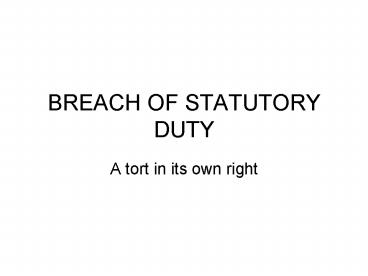BREACH OF STATUTORY DUTY - PowerPoint PPT Presentation
1 / 13
Title:
BREACH OF STATUTORY DUTY
Description:
Claims arise in tort for breach of duties created by statute to deal with a wide ... In Corr v IBC Vehicles [2006] EWCA Civ 331, the defendant was liable for a ... – PowerPoint PPT presentation
Number of Views:238
Avg rating:3.0/5.0
Title: BREACH OF STATUTORY DUTY
1
BREACH OF STATUTORY DUTY
- A tort in its own right
2
A complex area of law involving number of
propositions.
- Claims arise in tort for breach of duties created
by statute to deal with a wide range of issues,
often involving health and safety - Note the overlap with employers liability
- Heavy emphasis throughout on statutory
interpretation
3
Claimant must prove
- the statute was intended to create civil
liability. - the statutory duty was owed to the individual
claimant - the statute imposed the duty on the defendant
- the defendant was in breach of the duty
- the claimant suffered damage as a result, which
was of a type contemplated by the statute.
4
The statute was intended to create civil
liability
- Statute in question would not normally be
concerned with civil claims - Courts take various factors into account when
deciding upon the intention of Parliament - the general context of the statute?
- the precise nature of the statutory provisions?
5
The statutory duty was owed to the individual
claimant
- Cases turn on their own facts
- Hewett v Alf Browns Transport 1992
- Maguire v Hartland Wolff plc 2005
- PRP Architects v Reid 2007
6
The statutory duty was imposed on the particular
defendant
- Only if the statute imposes a duty on the
defendant can a civil claim be maintained - Majrowski v Guys and St Thomass NHS Trust
2006
7
The defendant was in breach of the statutory duty
- Note possible reversal of burden of proof to
the advantage of the claimant - must or shall usually mean strict liability
- Courts frequently lean against the imposition of
strict liability unless the statute specifically
states that strict liability will apply.
8
Reasonably practicable
- In Nimmo v Alexander Cowan and Sons 1968 the
House of Lords held that reasonably
practicable, used in various statutes, required
the employer to demonstrate that he or she had
taken such precautions as were reasonably
practicable or that precautions were
impracticable.
9
Damage must be of a type which the statute
contemplated
- There can only be a claim for breach of statutory
duty if the damage which was suffered was within
the contemplation of the objects of the statute.
10
Test to be applied
- Ordinary test of reasonable foresight appliesin
claims for breach of statutory duty. - As long as the damage is of a type that was
reasonably foreseeable, the extent of the damage
does not need to be foreseeable. In Corr v IBC
Vehicles 2006 EWCA Civ 331, the defendant was
liable for a suicide, where the deceased had
become depressed following injuries sustained as
a result of a breach of duty. It was held by the
Court of Appeal that it is not necessary to that
suicide was a type of damage that was separate
from psychiatric injury or personal injury.
11
Breaches of EU legislation
- In Fracovitch v Italy 1995
- Three Rivers DC v Bank of England (No 3) 1984
- R v Secretary of State for Transport ex part
Factortame (No 5) 2000
12
Human Rights Developments
- Marcic v Thames Water Utilities Ltd2003
- Secretary of State For Justice v Walker
Secretary of State For Justice v James 2008
13
Defences
- Normal tort defences apply where appropriate































